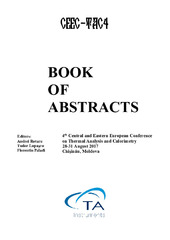Prikaz osnovnih podataka o dokumentu
Non-isothermal degradation of zinc–isophthalate complex with 2,2’-dipyridylamine
| dc.creator | Zdravković, Jelena D. | |
| dc.creator | Radovanović, Lidija | |
| dc.creator | Poleti, Dejan | |
| dc.creator | Rogan, Jelena | |
| dc.creator | Mészásaros Szécsényi, Katalin | |
| dc.creator | Vulić, Predrag J. | |
| dc.creator | Minić, Dragica M. | |
| dc.date.accessioned | 2023-10-20T10:13:15Z | |
| dc.date.available | 2023-10-20T10:13:15Z | |
| dc.date.issued | 2017 | |
| dc.identifier.isbn | 978-3-940237-47-7 | |
| dc.identifier.uri | http://TechnoRep.tmf.bg.ac.rs/handle/123456789/6702 | |
| dc.description.abstract | The design and synthesis of various mixed ligand complexes with amazing architecture and topology are promoted due to their potential applications as functional materials in fields such as gas storage, chemical separation, catalysis and luminescence [1]. The structural diversity and properties of these materials strongly depend on the organic Odonor ligand. For example, dianion of isophthalic (ipht) acid is widely used as ligand due to its ability to coordinate up to four metal centres with different coordination modes. The addition of Ndonor ligands significantly contributes to their structural versatility increasing their thermal stability [2]. There are only three ipht complexes containing dipya (2,2’-dipyridylamine) as N-donor ligand recently published: [Cu(dipya)(ipht)]·H2O [2, 3], [Mn(dipya)(ipht)]n [4] and [Zn(dipya)(ipht)]n [5]. The highest thermal stability was observed for [Zn(dipya)(ipht)]n. In addition, [Zn(dipya)(ipht)]n exhibits also a great antibacterial activity [4]. The decomposition of [Zn(dipya)(ipht)]n was studied in detail using simultaneous TG/DSC analysis in conjunction with TG/MS measurements and XRPD analysis in nitrogen atmosphere under non-isothermal conditions at four heating rates: 15, 20, 25 and 30 ºC min−1 . The first two decomposition steps are highly overlapped and for that reason the peak deconvolution using FraserSuzuki function was employed. The deconvolution was performed at each heating rate and the three single step processes were isolated. The application of isoconversional method confirmed that deconvoluted steps are individual processes while the determination of conversion functions was done according to the Màlek algorithm [6]. The third degradation step ends around 970 ºC, depending on the heating rate, yielding ZnO. | sr |
| dc.language.iso | en | sr |
| dc.publisher | Central and Eastern European Committee for Thermal Analysis and Calorimetry | sr |
| dc.relation | info:eu-repo/grantAgreement/MESTD/Integrated and Interdisciplinary Research (IIR or III)/45007/RS// | sr |
| dc.rights | openAccess | sr |
| dc.rights.uri | https://creativecommons.org/licenses/by/4.0/ | |
| dc.source | Book of abstracts / 4th Central and Eastern European Conference on Thermal Analysis and Calorimetry (CEEC-TAC4), 28-31 August 2017, Chişinău, Moldova | sr |
| dc.title | Non-isothermal degradation of zinc–isophthalate complex with 2,2’-dipyridylamine | sr |
| dc.type | conferenceObject | sr |
| dc.rights.license | BY | sr |
| dc.citation.spage | 209 | |
| dc.identifier.fulltext | http://TechnoRep.tmf.bg.ac.rs/bitstream/id/18138/bitstream_18138.pdf | |
| dc.identifier.rcub | https://hdl.handle.net/21.15107/rcub_technorep_6702 | |
| dc.type.version | publishedVersion | sr |

